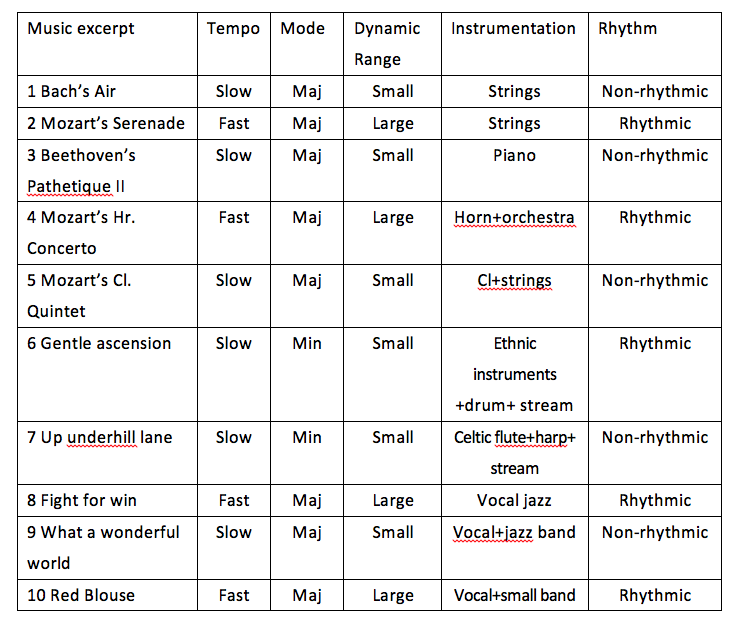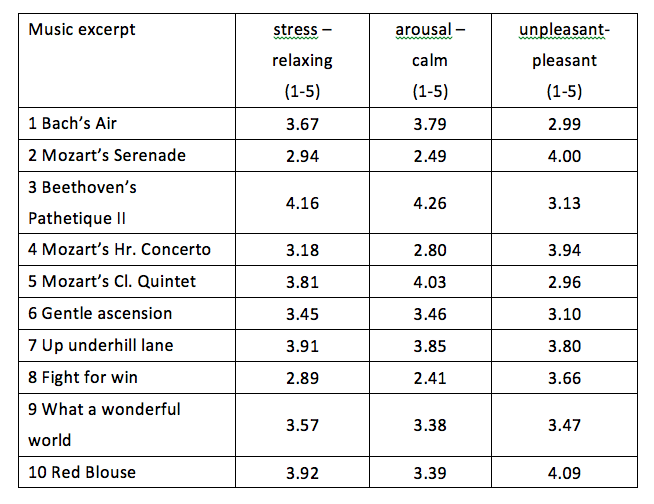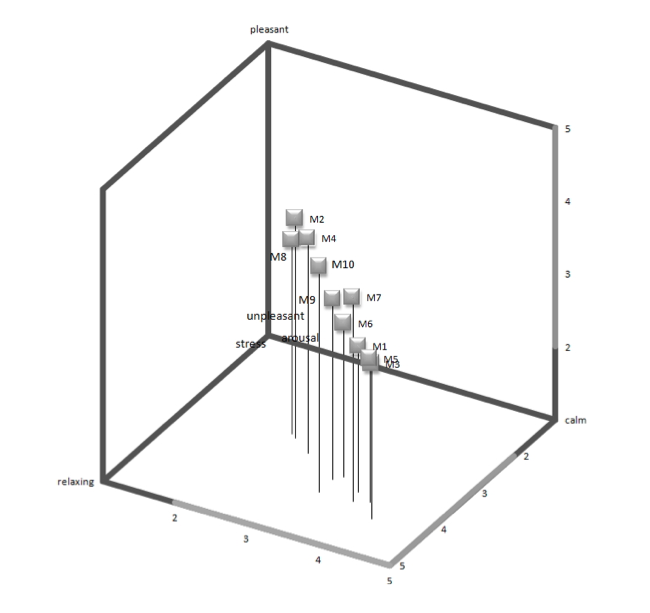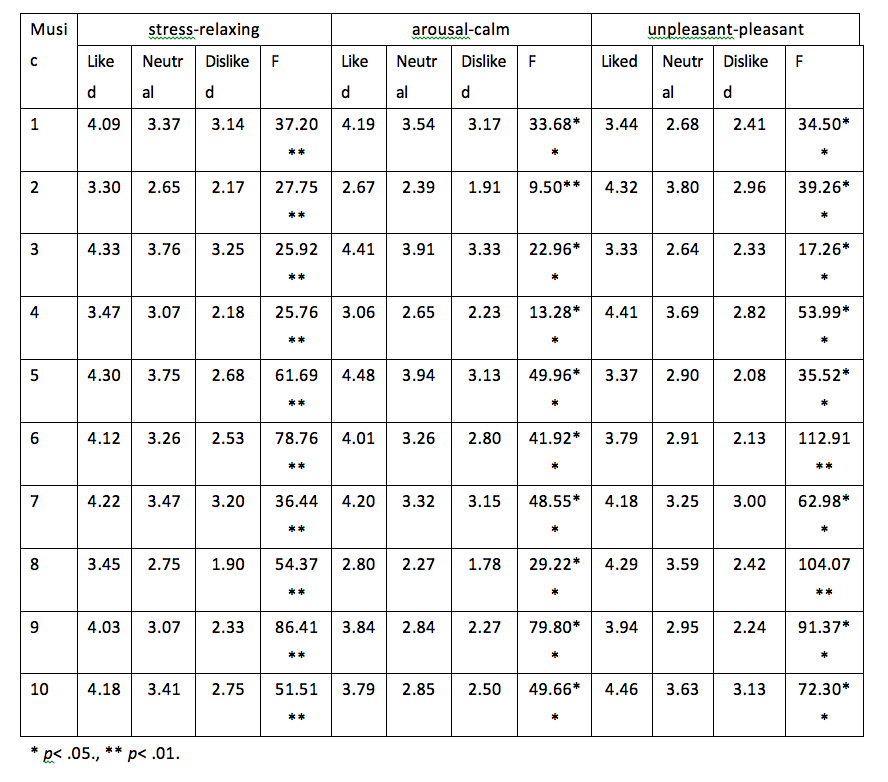
Table 1. The features of each music excerpt
Wei-Chun Wang – vgnwang@mail.ntust.edu.tw
Department of Humanities & Social Science
National Taiwan University of Science and Technology
No. 43, Sec. 4, Keelung Rd.
Taipei, Taiwan, R.O.C.
Popular version of paper 1pMU10
Presented Monday afternoon, May 5, 2014
167th ASA Meeting, Providence
---------------------------------
It is believed that music has the power to reduce negative emotions and alleviate pains. Press reports that young people often have a collection of favorite music that they listen to when they are feeling stressed out. This study was aimed at exploring the effects of music preference and stress-associated responses of college students when they listen to music. In addition to the students’ favorite music types, the correlations between music properties, college students’ music preference, music expertise and degree of perceived relaxation in music were investigated.
Methods
297 undergraduate students listened to 10 relaxing music excerpts (see Table 1) and rated their three stress-associated responses (stress-relaxing, arousal-calm, and unpleasant-pleasant) on 5-point Likert scale. In addition, music preference and degree of understanding music content were requested. Participants’ background information, such as study field, gender, leisure listening music types, music studies and experiences were collected as well.

Table 1. The features of each music excerpt
Favorite music types for college students
College students' favorite music styles were Mandarin popular songs, western popular songs and classical music, in that order. The differences by study field and gender are shown on Figures 1 and 2. The effect of music preference differed by study field. Not surprisingly, those students studying music enjoyed classical music more than business and engineering majors. For the gender effect, the results showed that female students tended to prefer light music while male students prefer rock and metal music more than females, which supported the findings of previous studies (Christenson and Peterson, 1988; Herberger, 1987; Thompson, 1990).

Figure 1. Listening types among study field

Figure 2. Listening types by gender
Three-dimensional emotions on music excerpts
Means of 3-dimensional emotions (stress-relaxing, arousal-calm, unpleasant-pleasant) for 10 music excerpts are shown as following (see Table 2 and Figure 3).

Table 2. Means of 3-dimensional emotions for music excerpts

Figure 3. Means of 3-dimensional emotions for 10 music excerpts
Music preference effect
Music preference is a self-perpetuating feedback loop arising from many different components such as the music properties and listeners’ music background (Tan, Yowler, Super & Fratianne, 2012). Listening to preferred music increases positive sensory experiences, resulting in positive chemical changes in the body. In this study, there was a strong music preference effect on 3-dimension emotional value for music excerpts (see Table 3). The more students liked the music, the more positive emotions students felt.

Table 3. 3-Dimensional Value by Music preference for Music Excerpts
Music Properties
Previous studies indicate the pairing of mood descriptors with particular musical elements. Happy, exuberant, joyous and lively emotions tend to be associated with fast tempi, major modality, loud dynamics, staccato articulations, simple harmonic structures, flowing rhythms, and higher pitches or wider pitch range. Conversely, sad, reflective, melancholy, longing and solemn emotions often correspond to slower tempi, minor modality, soft dynamics, legato articulations, complex harmonies, firm and slow rhythms, and narrow pitch range in the lower octaves (Boltz et al., 2009; Crozier, 1981; Gabrielsson & Lindstrom, 2001; Hunter, 2010; Juslin, 1997; Madsen et al., 1993; Wang, 2012). Among the various factors specifying mood in the auditory modality, tempo and mode appear to be the most influential (Gabrielsson & Lindstrom, 2001; Tsang & Schloss, 2010). Sedative music tends to have sustained melodic lines, non-percussive, quiet, even and simple rhythms with lots of repetition. However, excitative music could have a sedative effect on people if they listen to it repeatedly (Iwanaga et al., 1996). Degree of relaxation increased with decreased tempo and melodic and rhythmic complexity, variation in dynamics and smaller combinations of instruments. The results of this study indicated that perceived degree of relaxation and calmness increased when tempo, dynamic range, and rhythmic complexity decreased. However, mode effect wasn’t significant on college students’ perception of pleasantness.
These findings were expected to help university students to search suitable repertoire in terms of stress releasing, and offer advice for music appreciation teachers, psychological consultation personnel, and clinical therapists.
References:
Boltz, M. Ebendorf, B, & Field, B. (2009). Audiovisual interactions: the impact of visual information on music perception and memory. Music Perception, 27(1), 43-59.
Christenson, P. G., and Peterson, J. (1988). Genre and gender in the structure of music preferences. Communication Research, 15, 282–301.
Crozier,J. B. (1981). Information theory and melodic perception: In search of the aesthetic engram. In H. I. Day (Ed.), Advances in intrinsic motivation and aesthetics (p . 433-461). New York: Plenum.
Gabrielsson, A.,& lindstrom, E.(2001). The influence of musical structure on emotional expression. In P.Juslin & J. Sloboda (Eds.), Music and emotion, (pp.223-248). Oxford, UK: Oxford University Press.
Herberger, R. (1987). The degree of attractiveness to 15-year-old high school students in the German Democratic Republic (GDR) of different styles, genres, and trends of contemporary music - Results of a factor analysis. The Bulletin of the Council for Research in Music Education,91, 70–76.
Hunter, P.G., Schellenberg, E., & Schimmack, U. (2010). Feelings and perceptions of happiness and sadness induced by music: Similarities, differences, and mixed emotions. Psychology of Aesthetics, Creativity and the Arts, 4, 47-56.
Iwanaga, M., Ikeda, M., & Iwaki, T. (1996). The effects of repetitive exposure to music on subjective and physiological responses. Journal of Music Therapy, 33, 219–230.
Juslin, P. (1997). Perceived emotional expression in synthesized performances of a short melody: Capturing the listener’s judgment policy. Musicae Scientiae, 1, 225-256.
Madsen, C. K., Brittin, R. V., & Capperella-Sheldon, D. A. (1993). An empirical- method for measuring the aesthetic experience to music. Journal of Research in Music Education, 41(1), 57-69.Labbé, E., Schmidt, N., Babin, J., & Pharr, M. (2007). Coping with stress: the effectiveness of different types of music. Applied psychophysiology and biofeedback, 32(3-4), 163-168.
Tan, X., Yowler, C.J., Super, D.M.,& Fratianne, R.B. (2012). The interplay of preference, familiarity and psychophysical properties in defining relaxation music. Journal of Music Therapy, 49 (2), 150–179.
Taylor, D. B. (1973). Subject responses to precategorized stimulative and sedative music. Journal of Music Therapy, 10, 86–94.
Thaut, M. H., & Davis, W. B. (1993). The influence of subject-selected versus experimenter-chosen music on affect, anxiety, and relaxation. Journal of MusicTherapy, 30, 210–223.
Thompson, K. P. (1990). What do we know about teenagers and popular music? Quires, 19(4), 14–16.
Tsang, T. & Schloss, K.B. (2010). Associations between Color and Music are Mediated by Emotion and Influenced by Tempo. The Yale Review of Undergraduate Research in Psychology, 83-84.
Wang, W. (2012). Effects of Age Level and Gender on Emotional Response to Musical and Visual Stimuli by Two-dimensional Mood Scale, Proceedings of the 18th International Seminar of the Commission on Music in Special Education, Music Therapy, and Music Medicine. (Ed.). Lyn E. Schraer-Joiner, ISBN: 9780987351166 (e-book), (Nedlands, W.A.: International Society for Music Education), 2012.